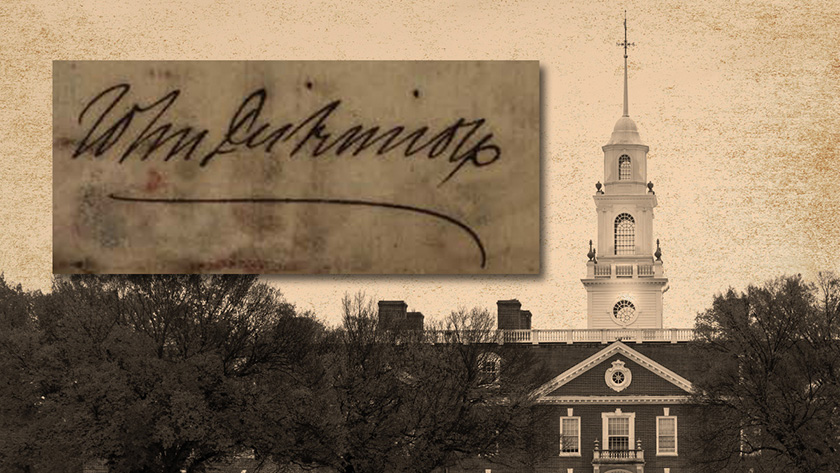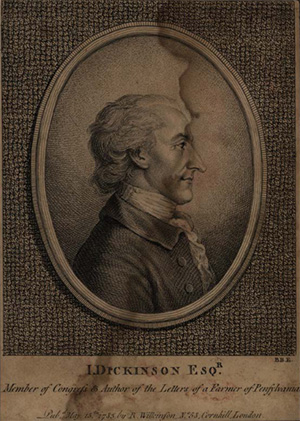
Signature of John Dickinson, the “Penman of the Revolution,” who was one of five delegates from Delaware to sign the U.S. Constitution. The state capitol building of Delaware is in the background.
Delaware Day: Remembering John Dickinson
By David Cardillo, Digital Initiatives and Preservation Department
In September 1787, five delegates from Delaware attended the Constitutional Convention and signed the U.S. Constitution—Richard Bassett, Gunning Bedford Jr., Jacob Broom, John Dickinson and George Read. Then sent to the states, the constitution would become binding when nine of the 13 colonies ratified the document.
On December 7, 1787, Delaware became the first state to do so. Now, Delawareans celebrate “Delaware Day” on December 7 to mark the occasion that earned Delaware its “First State” moniker.

Etching of John Dickinson in profile.
Known as the “Penman of the Revolution,” Dickinson was perhaps the most prominent of the delegates sent from Delaware to the Constitutional Convention. He was a member of both the First and Second Continental Congresses, wrote the first draft of the Articles of Confederation, and served as the President of Delaware from 1781-1783. (During that time, the heads of several newly independent states were referred to as president instead of governor.)
In the University of Delaware’s Special Collections, there are several letters written by John Dickinson that have been digitized and are publicly available. Each letter stands as a carefully preserved historical artifact.
In one letter, Dickinson writes to thank Tench Coxe, an economist and delegate from Pennsylvania to the Continental Congress. The letter includes an etched profile portrait of Dickinson.
Another letter of note was co-authored by Thomas McKean, a fellow Delaware delegate to the Continental Congress, and was addressed to Delaware President Caesar Rodney. Written during the early part of the Revolutionary War, the letter asks Rodney for support in guarding and securing the 64 prisoners captured with the sloop-of-war Harlem, a British gunship.
More information about Dickinson, the Constitutional Convention and Delaware’s role in framing the Constitution is digitally and freely available through the Delaware records of the Federal Writers Project, a project that collaborated with state and local governments to compile oral histories, ethnographies, demographic information and more. Among other research in the Delaware records, there is an article in Volume 36 on the Constitutional Convention that mentions correspondence between Dickinson and fellow Constitution signer Read.
A key figure in the American founding, Dickinson is also familiar to Delawareans for the many things named in his honor. In addition to the John Dickinson School in Wilmington, Dickinson’s former plantation land is now owned by the State of Delaware, operated as a museum by the Delaware Division of Historical and Cultural Affairs, and open as a state park.
The letters of John Dickinson are made freely and digitally available through UD’s institutional repository, UDSpace, within the Delaware Miscellaneous Literary & Historical Manuscripts collection as well as the Federal Writers Project. Delaware Records, 1936-1941 collection. All these materials are in the public domain, and may be reused without restriction. The Library, Museums and Press is also working closely with the John Dickinson Project to publish 12 volumes of Dickinson’s writings and correspondence. Dickinson’s letters are particularly relevant for researchers who are interested in the American Revolution, the country’s founding, patriotism, public affairs and human rights.

